The New York Rangers’ rebuild is over. That was at least part of the message sent when owner James Dolan stunningly dismissed general manager Jeff Gorton and team president John Davidson near the end of last season, Dolan signaling that after three-plus years of tearing down and re-fortifying the roster, that the time had come to return to playoff contention.
The executive chairman and CEO of Madison Square Garden Sports wants to start seeing certainty in the Blueshirts’ lineup, a consistency to the pieces that will lead the team back toward competing for the Stanley Cup.
Nowhere is this more true than at center, where the club needs to figure out this season how it will look down the middle for the foreseeable future – a task that may prove considerably more complicated than at other positions.
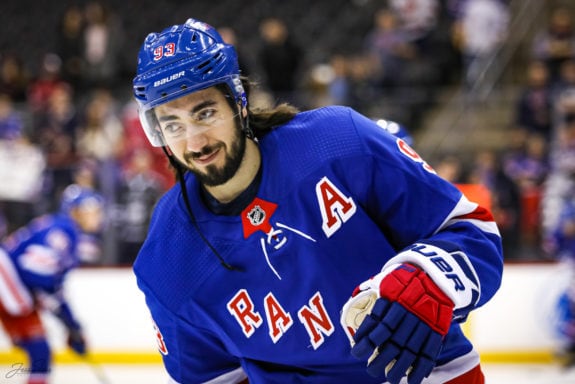
That’s because Gorton’s replacement, Chris Drury, has to deal with many moving parts. His current top two centers are set to be unrestricted free agents after 2021-22, and it’s possible neither of them are going to be core pieces going forward. There’s a promising youngster who has yet deliver on his talent – with no guarantee he’ll do so, or if center is even the best position for him. And there’s a big potential trade piece who could be destined for Broadway – or could be someone to avoid.
Our look at the Rangers’ center situation doesn’t provide any answers – just an illustration of the question marks that the club can’t afford to live with much longer.
Is Mika Zibanejad a Clear-Cut No. 1 Center?
Highlighting a recurring theme, this one should be easy – but it’s not. Mika Zibanejad, who’s blossomed into an offensive force and ostensible No. 1 pivot while working on one of the most team-friendly contracts in the NHL, becomes a UFA next summer.
A point-per-game player over the past three seasons, including a 75-point effort in just 57 games in 2019-20, Zibanejad is set to cash in, provided he continues to produce at the same pace in 2021-22. Set to complete a five-year, $26.75 million contract, the 28-year-old is looking at an average annual value of $9-10 million in his next deal. It’s an easy call to re-sign him, right?
Perhaps not. Zibanejad is sure to demand a maximum eight-year term from the Rangers to stay. That means he would be 37 when that theoretical pact expires. How well will that age?
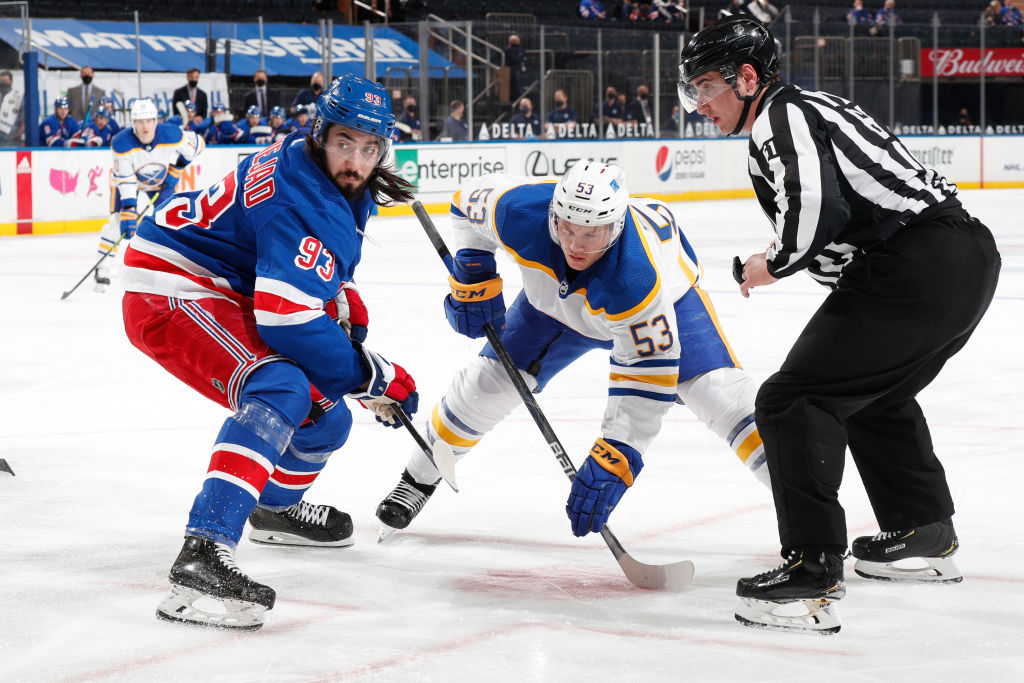
If there hadn’t been any concerns last season, the Rangers probably wouldn’t worry about five years down the line – but there were, in fact, concerns. Zibanejad totaled 50 points in playing all 56 games of the shortened season and overcame an ice-cold start that was likely due in part to his contracting COVID before training camp. However, much of his production came against weaker teams, a season after he had raised his game against some of the Rangers’ better opponents. In addition, his faceoff win percentage dropped for the third season in a row, and advanced analytics also didn’t paint a pretty picture of his 2020-21 season.
The No. 6 pick in the 2011 NHL draft is one of the league’s great natural scorers, and the Rangers might be crazy to consider doing anything but offering him a big extension. In that case, Drury has to hope he’d be getting a true No. 1 center who will maintain that distinction through most of a huge contract. A fast start from Zibanejad to 2021-22 would certainly make Drury’s decision easier.
Is Ryan Strome a Late Bloomer, or Just Along For the Ride With Panarin?
The 28-year-old represents an even bigger conundrum for the front office. Like Zibanejad, who was robbed from the Ottawa Senators in a July 2016 trade, Ryan Strome arrived in what’s proved to be a lopsided swap with the Edmonton Oilers. The player drafted one spot in front of Zibanejad 10 years ago has totaled 141 points in 189 games over nearly three seasons in Rangers sweater, forging strong chemistry with superstar left wing Artemi Panarin during the past two seasons.
So is Strome finally living up to his pedigree as a top-five draft pick, a late bloomer who can ably hold down the No. 2 spot into the future? Perhaps, but again, nothing’s simple down the middle for this team at the moment. The uncertainty over whether to commit long-term to a player initially acquired as a stopgap in exchange for the forgettable Ryan Spooner is due ironically to that partnership with Panarin.
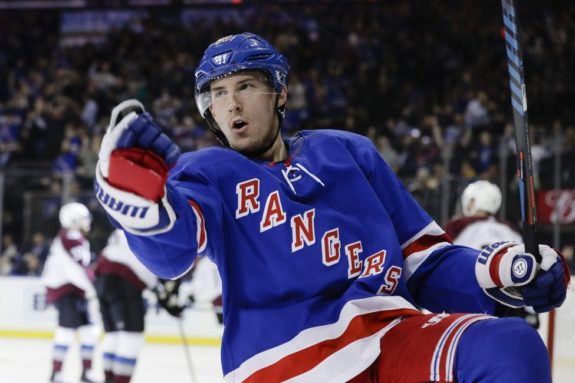
The central question here – is Strome’s blossoming a result of an invaluable chemistry with the dynamic Panarin that the Rangers can’t easily replace, or is he simply riding Panarin’s coattails, taking advantage of the Bread Man’s pinpoint passing and constant creation of golden offensive oppotunities to inflate his point totals?
The answer isn’t clear, and there hasn’t been much in the way of an effort to find out. Strome and Panarin have played together consistently since the latter arrived as a big-ticket free agent in 2019, leaving the team with scant evidence with which to draw an evaluation. The Rangers need to be sure they can count on Strome to be the same player if he has to play without Panarin before giving him an extension that’s likely to be for 5-6 years at a cap hit of $6 million or so.
In an encouraging – albeit brief – sample that spanned late February and March, Strome recorded four goals and five assists in a nine-game stretch with Panarin away from the team, an absence stemming from a controversial and unsubstantiated accusation which emerged from his native Russia that he assaulted a woman in a bar 10 years earlier.
Strome’s career Corsi For of 53.0 indicates that he drove possession before teaming up with Panarin, but his ugly career faceoff percentage of 45.2 – including 43.2 last season – would be a major problem over the long haul for a team that has struggled badly at the dots for years. Whether to extend Strome seems certain to be a very tough call.
Is Filip Chytil a Future Top-Six Center, or Better Suited to the Wing?
It only seems as if the 21st overall pick in the 2017 draft has been around forever. In reality, Filip Chytil turned 22 on Sunday and is going into his fifth season with the Rangers – though he’s averaged less than 47 games per in his NHL career. There are still so many question marks surrounding the 6-foot-2, 206-pound Czech, who was barely 18 when he made a nine-game cameo in a Blueshirt to start 2017-18 before being sent down, his game obviously not ready for prime time.
Chytil’s failure to establish himself has nothing to do with a lack of talent, and he can’t be called a bust at this point, either. With speed, size and great hands, the Rangers have to be at least somewhat frustrated at Chytil’s up-and-down career and inability to take the next step.
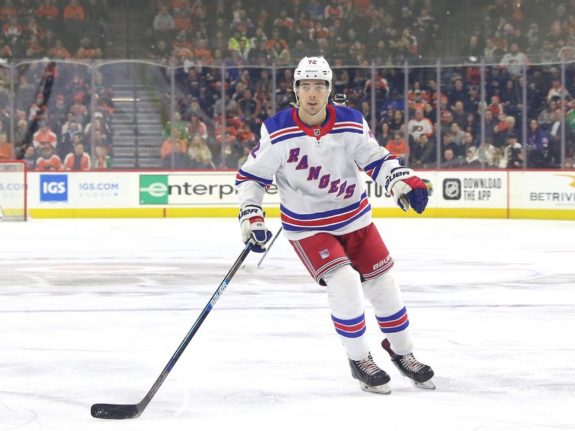
Yet the organization has to accept a decent amount of blame for that as well. From being forced into the lineup early, to recently not getting enough of a chance to prove that he belongs, Chytil’s development hasn’t always been managed well. Not all of that can be blamed on former coach David Quinn, who in three seasons felt he didn’t see enough from Chytil to give him more responsibility. The end result, though, is that the Rangers still aren’t sure what they have in the player who flashes so much promise, but has yet to show he can handle the responsibilities of playing in the middle in the NHL.
Chytil’s possession numbers aren’t great – his career Corsi For percentage is 49.7 – and his work on draws is downright abysmal, at under 40 percent. It’s possible both numbers would improve with more ice time and better linemates, but again, the Rangers haven’t seemed willing to find out so far – unfortunate considering they’ve spent the past three years supposedly focused on player development.
Chytil seems to have been at his best when he’s played wing, using his speed and excellent hands to beat defensemen along the right boards before cutting hard to the net for scoring chances. After signing him to a two-year, $4.6 million bridge deal this offseason, the Rangers have to decide in 2021-22 whether to finally give Chytil top-six minutes in the middle in the hope that a low-cost, high-end No. 2 center option emerges, accept that he’s better off as a winger – or use him as trade fodder.
An injury and contracting COVID also hampered Chytil in 2020-21, and he rarely played above the third line. With Zibanejad and Strome unsigned for next season, the Blueshirts need to know whether Chytil is a candidate to fill one of those spots in 2022-23 if necessary. Could he replace Strome behind ZIbanejad? It’s time to find out.
Is Jack Eichel Being Fitted For a Blueshirt – or Should the Rangers Pass on Him?
The prospect of acquiring the Buffalo Sabres’ star center has hung over the club for more than a year now, since the Rangers reportedly made an offer for him last summer that was rebuffed. Jack Eichel is a bonafide No. 1 pivot, with 355 points in 375 career games, is only 24 and available, given the level of acrimony between player and team that appears to have reached a point of no return.
Acquiring him, though, will likely cost the Rangers a huge price in young players and draft picks; his exorbitant contract, which runs for five more years with a $10 million AAV, would probably force the Rangers to bid farewell to Zibanejad after this season; and perhaps most importantly, Eichel is dealing with a neck injury that looks like it will require surgery – a major point of contention with the Sabres – after it limited him to 18 games last season.
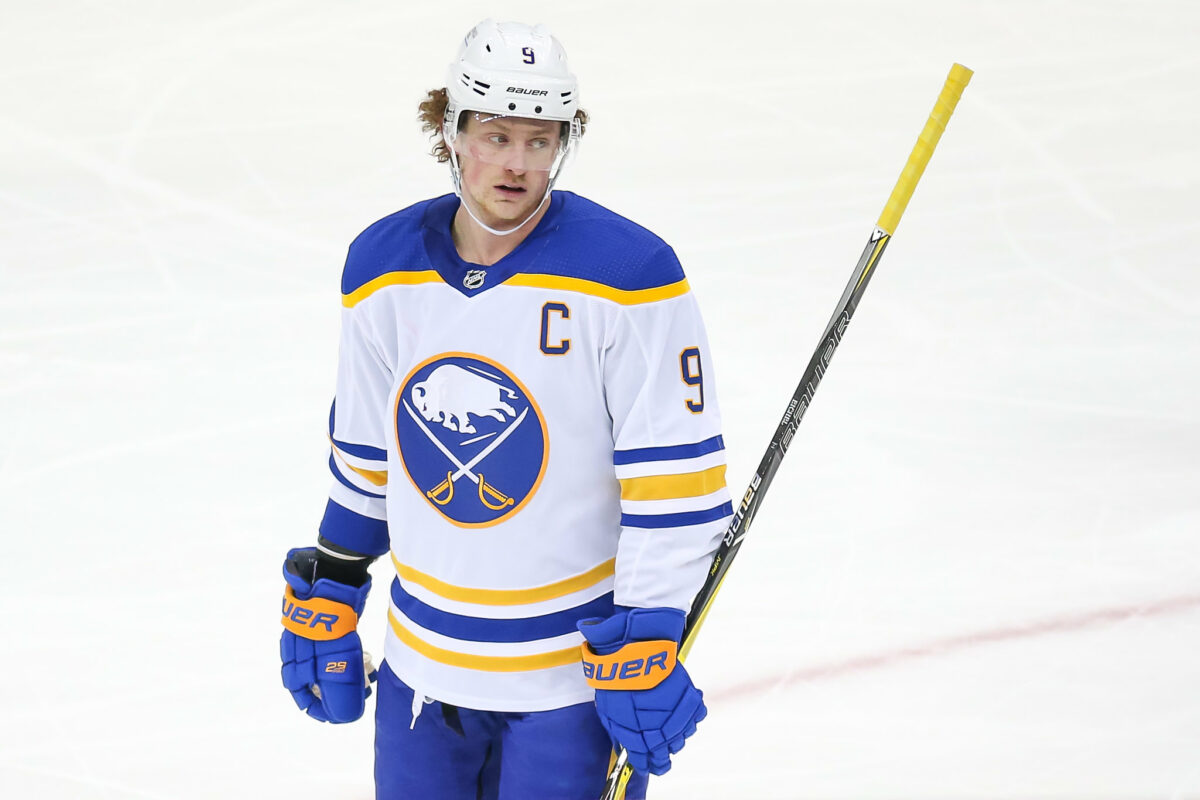
All of that has created overwhelming uncertainty around the player’s future. Drury would love to add a center of Eichel’s stature, but the roadblocks/red flags that stand in the way of doing so at the moment are considerable. Even if Eichel were healthy, trading at least two or three of the high-end young assets the Rangers have built up since February 2018 represents a major sacrifice of talent – and might not make the team better overall.
Drury hasn’t forced the issue and appears to be in a wait-and-see mode. He’s likely holding off until Buffalo’s asking price comes down, as well as for clarity on Eichel’s injury issue. That’s the proper approach, but at some point soon, the GM has to decide whether to remain in the hunt for the No. 2 overall pick in the 2015 draft or move forward with a different plan to firm up the center situation. Most critically, the Rangers need to engage in deeper talks with Zibanejad soon if they’re interested in laying the groundwork for an extension. Drury needs to keep his team from being held hostage by the possibility of acquiring Eichel.
Drury Has a Salary Cap to Worry About
Regardless of what path Drury takes, he has to be able to manage a salary cap picture that has grown increasingly tight with offseason moves – and which promises to get even tighter as the entry-level contracts of several key youngsters expire in the next few seasons. That means knowing whether the Rangers are planning to absorb Eichel’s contract, re-upping ZIbanejad and/or Strome or trying to save money by installing Chytil as the No. 2. It’s going to be a major balancing act, and the GM can’t afford to wait any longer to find out how he’s going to attack it.
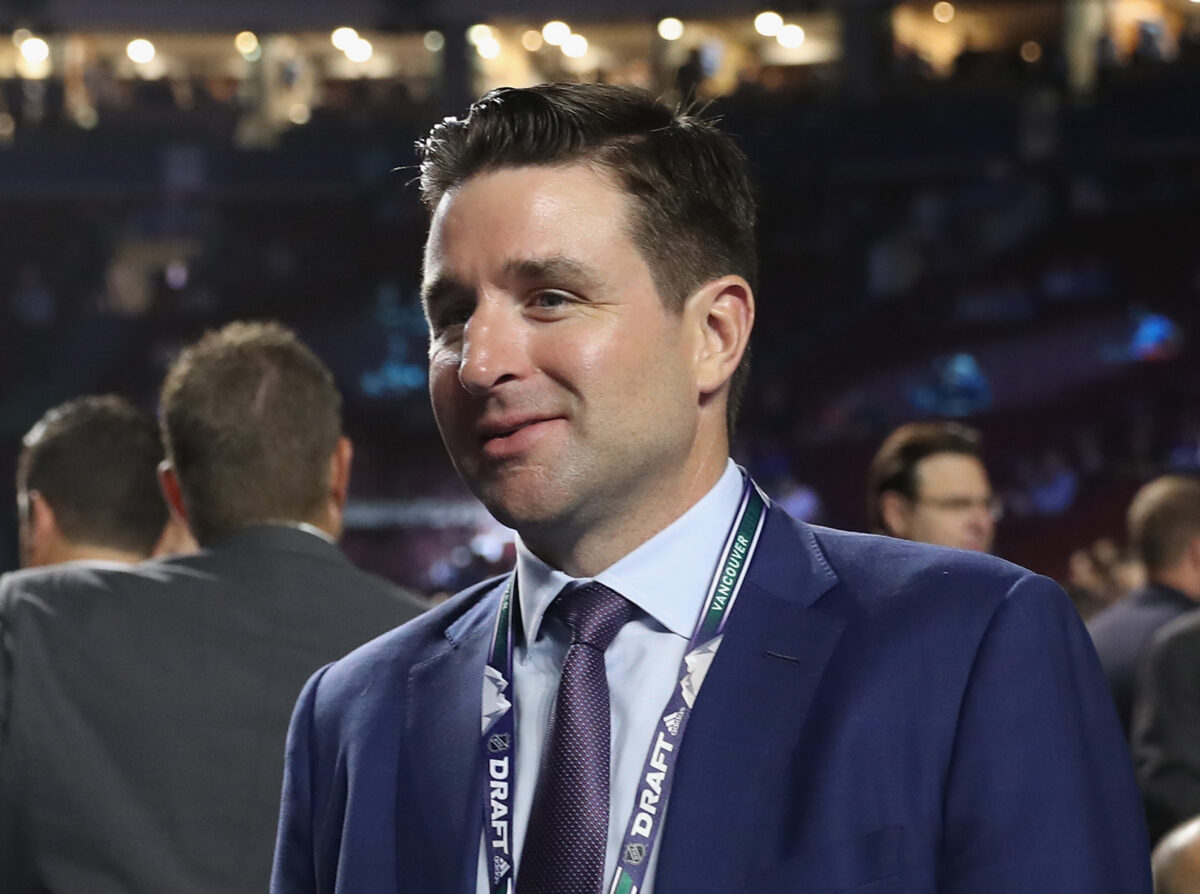
Next season might be about the present on the ice, as the Blueshirts hope to make a push for the playoffs. It’s also going to be about the future state of the roster as circumstance forces the Rangers to finally make hard decisions, especially who the men in the middle will be going forward.